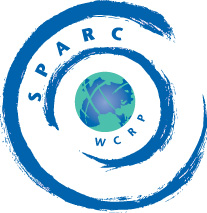 |
Stratospheric Processes And their Role in Climate
|
||||||||
| Home | Initiatives | Organisation | Publications | Meetings | Acronyms and Abbreviations | Useful Links |
![]()
 |
Stratospheric Processes And their Role in Climate
|
||||||||
| Home | Initiatives | Organisation | Publications | Meetings | Acronyms and Abbreviations | Useful Links |
![]()
Executive Summary of the 2002 Scientific Assessment of Ozone Depletion is Released
Assessment Panel Cochairs: A.-L. Ajavon, D. Albritton, G. Mégie, and B. Watson
On 23 August 2002, the World Meteorological Organization (WMO) and the United Nations Environment Programme (UNEP) jointly released the Executive Summary of the "Scientific Assessment of Ozone Depletion: 2002." The Executive Summary is available at the following web sites of these sponsoring organizations: http://www.wmo.ch/web/arep/ozone.html and http://www.unep.org/ozone/publications.shtml.
The Executive Summary describes the main scientific points, established at a peer-review meeting on 24 – 28 June 2002. This assessment report will be one of the quadrennial reports to the Montreal Protocol on the status of the understanding of the stratospheric ozone layer. Participating in the writing and review of the 2002 report were 269 scientists worldwide. The printed report will be available in April, 2003. NOAA, NASA, and the European Commission co-sponsor the report's publication. Along with the Executive Summary and the five chapters will be "Twenty Questions and Answers About the Ozone Layer" which is written for a broad readership of decision-makers, educators, students, and the general public.
The key points from the Executive Summary of the "Scientific Assessment of Ozone Depletion: 2002" are the following:
Recent Major Findings and Current Scientific Understanding
Changes in ozone-depleting compounds
- In the troposphere (i.e., lower atmosphere), observations show that the total combined effective abundance of ozone-depleting compounds continues to decline slowly from the peak that occurred in 1992-1994. Total chlorine is declining, while bromine from industrial halons is still increasing, albeit at a slower rate than was occurring previously (and as reported in the 1998 Assessment).
- Analyses of air trapped in snow since the late 19th century have confirmed that non-industrial sources of the CFCs, halons, and major chlorocarbons were insignificant.
- The abundances of HCFCs in the lower atmosphere continue to increase.
- Observations in the stratosphere indicate that the total chlorine abundance is at or near a peak, while bromine abundances are probably still increasing.
- Very short-lived organic chlorine-, bromine-, and iodine-containing source gases have the potential to deplete stratospheric ozone, but quantitative estimation of their potentials is more challenging than for longer-lived species like CFCs.
Changes in the ozone layer over the poles and globally
- Springtime Antarctic ozone depletion due to halogens has been large throughout the last decade.
- In some recent cold Arctic winters during the last decade, maximum total column ozone losses due to halogens have reached 30%.
- Ozone remains depleted in the mid-latitudes of both hemispheres.
- Models including observed changes in halocarbons, source gases, and aerosols (i.e., airborne fine particles) capture the observed long-term ozone changes in northern and southern mid-latitudes.
- Chemistry-climate models predict that springtime Antarctic ozone levels will be increasing by 2010 due to projected decreases of halogens in the stratosphere.
- Arctic ozone depletion is highly variable and difficult to predict, but a future Arctic polar ozone hole similar to that of the Antarctic appears unlikely.
- The global ozone layer recovery is expected to be linked mainly to decreasing chlorine and bromine loading, but other factors are likely to contribute.
Changes in ultraviolet radiation- Changes in the duration and spatial extent of the ozone hole are more important for Antarctic surface ultraviolet (UV) radiation levels than the annual ozone minimum.
- Additional measurements continue to confirm that decreases in ozone column amounts lead to increases in UV radiation.
The ozone layer and climate change
- The understanding of the impact of ozone depletion on climate change has been strengthened.
- Other atmospheric changes influence both the ozone layer and the climate system.
- New research has begun to explore the coupling between climate change and the recovery of the ozone layer.
Implications for Policy Formulation
- The Montreal Protocol is working, and the ozone-layer depletion from the Protocol's controlled substances is expected to begin to ameliorate within the next decade or so.
- The ozone layer will remain particularly vulnerable during the next decade or so, even with full compliance. With the atmospheric abundances of ozone-depleting substances being near their highest, the human-influenced perturbations will be at or near their largest. Relative to the pre-ozone-hole abundances of 1980, the 1997-2001 losses in total column (i.e., overhead) ozone amounts are:
- about 4 % at northern mid-latitudes in winter/spring;
- about 2 % at northern mid-latitudes in summer/fall; and
- about 6 % at southern mid-latitudes on a year-round basis.
Calculations yield that such changes in ozone correspond to increases in surface erythemal radiation of at least 5, 2, and 7 %, respectively, if other influences such as clouds remain constant.
- Approaches to accelerating the recovery of the ozone layer are limited.
- Failure to comply with the Montreal Protocol would delay or could even prevent recovery of the ozone layer.
- Estimating the impacts of very short-lived ozone-depleting substances on depletion of the ozone layer requires new approaches, and, as requested by the Parties, this assessment has described one such scientific approach.
- The issues of ozone depletion and climate change are interconnected.
![]()